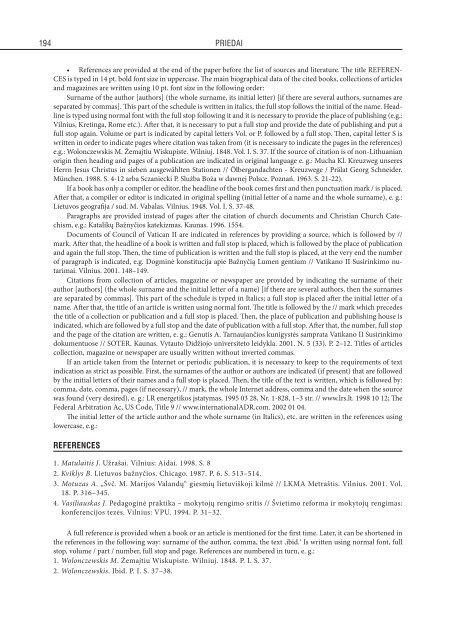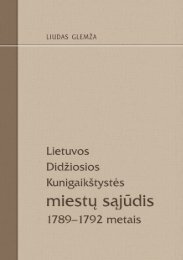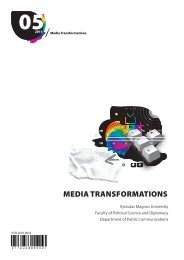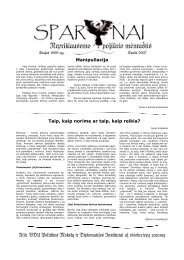Soter Nr. 26 - Vytauto Didžiojo universitetas
Soter Nr. 26 - Vytauto Didžiojo universitetas
Soter Nr. 26 - Vytauto Didžiojo universitetas
You also want an ePaper? Increase the reach of your titles
YUMPU automatically turns print PDFs into web optimized ePapers that Google loves.
194<br />
PRIEDAI<br />
• References are provided at the end of the paper before the list of sources and literature. The title REFEREN-<br />
CES is typed in 14 pt. bold font size in uppercase. The main biographical data of the cited books, collections of articles<br />
and magazines are written using 10 pt. font size in the following order:<br />
Surname of the author [authors] (the whole surname, its initial letter) [if there are several authors, surnames are<br />
separated by commas]. This part of the schedule is written in italics, the full stop follows the initial of the name. Headline<br />
is typed using normal font with the full stop following it and it is necessary to provide the place of publishing (e.g.:<br />
Vilnius, Kretinga, Rome etc.). After that, it is necessary to put a full stop and provide the date of publishing and put a<br />
full stop again. Volume or part is indicated by capital letters Vol. or P. followed by a full stop. Then, capital letter S is<br />
written in order to indicate pages where citation was taken from (it is necessary to indicate the pages in the references)<br />
e.g.: Wolonczewskis M. Žemajtiu Wiskupiste. Wilniuj. 1848. Vol. I. S. 37. If the source of citation is of non-Lithuanian<br />
origin then heading and pages of a publication are indicated in original language e. g.: Mucha Kl. Kreuzweg unseres<br />
Herrn Jesus Christus in sieben ausgewählten Stationen // Ölbergandachten - Kreuzwege / Prälat Georg Schneider.<br />
München. 1988. S. 4-12 arba Sczaniecki P. Slużba Boża w dawnej Polsce. Poznań. 1963. S. 21-22).<br />
If a book has only a compiler or editor, the headline of the book comes first and then punctuation mark / is placed.<br />
After that, a compiler or editor is indicated in original spelling (initial letter of a name and the whole surname), e. g.:<br />
Lietuvos geografija / sud. M. Vabalas. Vilnius. 1948. Vol. I. S. 37-48.<br />
Paragraphs are provided instead of pages after the citation of church documents and Christian Church Catechism,<br />
e.g.: Katalikų Bažnyčios katekizmas. Kaunas. 1996. 1554.<br />
Documents of Council of Vatican II are indicated in references by providing a source, which is followed by //<br />
mark. After that, the headline of a book is written and full stop is placed, which is followed by the place of publication<br />
and again the full stop. Then, the time of publication is written and the full stop is placed, at the very end the number<br />
of paragraph is indicated, e.g. Dogminė konstitucija apie Bažnyčią Lumen gentium // Vatikano II Susirinkimo nutarimai.<br />
Vilnius. 2001. 148–149.<br />
Citations from collection of articles, magazine or newspaper are provided by indicating the surname of their<br />
author [authors] (the whole surname and the initial letter of a name) [if there are several authors, then the surnames<br />
are separated by commas]. This part of the schedule is typed in Italics; a full stop is placed after the initial letter of a<br />
name. After that, the title of an article is written using normal font. The title is followed by the // mark which precedes<br />
the title of a collection or publication and a full stop is placed. Then, the place of publication and publishing house is<br />
indicated, which are followed by a full stop and the date of publication with a full stop. After that, the number, full stop<br />
and the page of the citation are written, e. g.: Genutis A. Tarnaujančios kunigystės samprata Vatikano II Susirinkimo<br />
dokumentuose // SOTER. Kaunas. <strong>Vytauto</strong> <strong>Didžiojo</strong> universiteto leidykla. 2001. N. 5 (33). P. 2–12. Titles of articles<br />
collection, magazine or newspaper are usually written without inverted commas.<br />
If an article taken from the Internet or periodic publication, it is necessary to keep to the requirements of text<br />
indication as strict as possible. First, the surnames of the author or authors are indicated (if present) that are followed<br />
by the initial letters of their names and a full stop is placed. Then, the title of the text is written, which is followed by:<br />
comma, date, comma, pages (if necessary), // mark, the whole Internet address, comma and the date when the source<br />
was found (very desired), e. g.: LR energetikos įstatymas, 1995 03 28, <strong>Nr</strong>. 1-828, 1–3 str. // www.lrs.lt. 1998 10 12; The<br />
Federal Arbitration Ac, US Code, Title 9 // www.internationalADR.com. 2002 01 04.<br />
The initial letter of the article author and the whole surname (in Italics), etc. are written in the references using<br />
lowercase, e.g.:<br />
REFERENCES<br />
1. Matulaitis J. Užrašai. Vilnius: Aidai. 1998. S. 8<br />
2. Kviklys B. Lietuvos bažnyčios. Chicago. 1987. P. 6. S. 513–514.<br />
3. Motuzas A. „Švč. M. Marijos Valandų“ giesmių lietuviškoji kilmė // LKMA Metraštis. Vilnius. 2001. Vol.<br />
18. P. 316–345.<br />
4. Vasiliauskas J. Pedagoginė praktika – mokytojų rengimo sritis // Švietimo reforma ir mokytojų rengimas:<br />
konferencijos tezės. Vilnius: VPU. 1994. P. 31–32.<br />
A full reference is provided when a book or an article is mentioned for the first time. Later, it can be shortened in<br />
the references in the following way: surname of the author, comma, the text ‚ibid.‘ Is written using normal font, full<br />
stop, volume / part / number, full stop and page. References are numbered in turn, e. g.:<br />
1. Wolonczewskis M. Žemajtiu Wiskupiste. Wilniuj. 1848. P. I. S. 37.<br />
2. Wolonczewskis. Ibid. P. I. S. 37–38.





